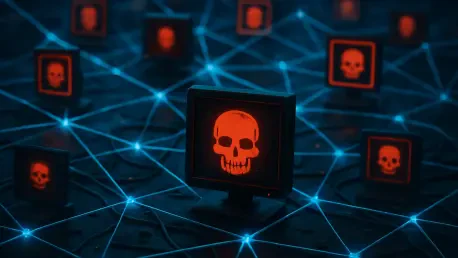In a sweeping blow to the shadowy world of cybercrime, Europol has orchestrated a monumental operation to dismantle the networks powering three notorious malware strains—Rhadamanthys, VenomRAT, and Elysium—that have plagued hundreds of thousands of Windows PCs across the globe, highlighting the pervasive danger of digital threats. These insidious programs have been stealthily stealing sensitive information, from passwords to cryptocurrency credentials, while transforming infected devices into weapons for larger-scale attacks. This international crackdown, involving law enforcement and cybersecurity experts, not only underscores the pervasive danger of digital threats but also shines a light on the sheer scale of damage inflicted on unsuspecting victims, many of whom remain unaware of the breaches.
The operation’s reach is staggering, with over 1,025 servers taken down and more than 20 internet domains brought under control, effectively disrupting the infrastructure that sustains these malware campaigns. A pivotal arrest of a key suspect linked to VenomRAT in Greece on November 3 further demonstrates the tangible outcomes of this coordinated effort. As cyber threats grow increasingly sophisticated, this achievement marks a critical step forward, though it also reveals the daunting challenges that lie ahead in securing the digital landscape against relentless adversaries.
The Scale and Impact of Malware Threats
Unpacking the Malware Menace
The trio of malware strains targeted in this operation—Rhadamanthys, VenomRAT, and Elysium—represents a chilling evolution in cyber threats, each designed with distinct but equally destructive capabilities. Rhadamanthys operates as an infostealer, siphoning off sensitive data like login credentials and browser histories from infected systems, often without any visible signs of compromise. VenomRAT, on the other hand, excels as a remote access Trojan, granting attackers full control over compromised PCs to execute further malicious actions. Elysium focuses on building botnets, turning thousands of devices into a collective force for attacks like Distributed Denial of Service (DDoS). Together, these threats have infected hundreds of thousands of devices worldwide, creating a sprawling network of stolen data and hijacked systems that fuel a dark underground economy.
Beyond their technical prowess, these malware strains reveal the sheer audacity of cybercriminals in exploiting trust and technology. They often infiltrate systems through deceptive means, such as phishing emails or counterfeit websites that mimic legitimate brands, catching even cautious users off guard. The scale of infection is staggering, with Europol estimating that millions of credentials have been harvested, many of which are sold on illicit marketplaces. This operation’s focus on dismantling the infrastructure behind these threats highlights the urgent need to address not just the malware itself, but the sprawling ecosystem that supports its distribution and monetization, a challenge that continues to test global cybersecurity efforts.
Victim Impact
The human toll of these malware campaigns is both profound and often invisible, as countless individuals and businesses suffer losses without even realizing they’ve been targeted. Stolen credentials, including passwords and banking details, frequently lead to identity theft or unauthorized access to personal accounts, leaving victims grappling with financial ruin or reputational damage. Small businesses, in particular, face devastating consequences when critical data is compromised, often lacking the resources to recover from such breaches. Europol’s findings suggest that the scale of these infections spans across continents, affecting a diverse range of victims who may never trace their misfortunes back to these specific malware strains, amplifying the hidden nature of the crisis.
Moreover, the financial stakes are astronomical, especially with Rhadamanthys reportedly accessing over 100,000 cryptocurrency wallets, potentially worth millions of euros. This theft not only impacts individual investors but also undermines confidence in digital currencies as a whole. The ripple effects extend further when infected devices are roped into botnets for large-scale attacks, disrupting services and causing broader economic harm. Public awareness campaigns, such as those promoted by Europol with tools like politie.nl/checkyourhack, aim to empower users to detect and mitigate these risks, but the sheer volume of affected systems suggests that many will remain vulnerable until systemic defenses are strengthened.
The Operation’s Reach and Collaboration
A Global Effort
The success of this operation hinges on an unprecedented level of international collaboration, with Europol at the helm uniting law enforcement agencies from across Europe and the US in a shared mission to cripple these malware networks. This partnership extended beyond government entities to include private cybersecurity leaders such as Proofpoint and CrowdStrike, whose technical expertise proved instrumental in mapping and disrupting the malicious infrastructure. The result was the seizure of over 1,025 servers, a critical blow to the operational backbone of Rhadamanthys, VenomRAT, and Elysium. This coordinated effort exemplifies how global unity can tackle threats that know no borders, setting a powerful precedent for future cybercrime interventions.
Equally significant was the strategic control over more than 20 internet domains that facilitated the spread and command of these malware strains. By severing these digital lifelines, the operation not only halted ongoing attacks but also disrupted the communication channels cybercriminals relied upon. This level of collaboration required meticulous planning and real-time intelligence sharing, demonstrating the complexity of modern cyber investigations. While the takedown represents a major victory, it also highlights the resource-intensive nature of such endeavors, underscoring the importance of sustained investment in cross-border cybersecurity alliances to keep pace with evolving threats.
Key Arrests and Disruptions
A defining moment in this operation was the arrest of a primary suspect behind VenomRAT in Greece on November 3, marking a rare instance where the human element of cybercrime faces tangible consequences. This individual’s apprehension sends a strong message to the underground community that anonymity is not guaranteed, and law enforcement is closing in on key players. The arrest also provides investigators with potential insights into the inner workings of these malware networks, possibly leading to further disruptions. Such actions are crucial in dismantling not just the technical infrastructure but also the organizational hierarchy that sustains these illicit operations over extended periods.
In parallel, the widespread disruption of malware infrastructure has had immediate effects, with reports indicating that cybercriminals have lost access to critical tools like Rhadamanthys following the server takedowns. Europol’s innovative tactics, including psychological operations like a video mocking Rhadamanthys operators, add another layer of deterrence by signaling that their activities are under intense scrutiny. These disruptions, while impactful, are not a complete solution, as the adaptability of cybercriminals suggests they may seek alternative methods or platforms. Nevertheless, these actions have significantly hampered current operations, buying valuable time for defenders to bolster protections and for affected users to secure their systems.
Evolving Cybercrime Challenges
Sophistication and Geopolitical Ties
The business-like sophistication of modern cybercrime is starkly evident in malware like Rhadamanthys, which operates on a subscription-based model akin to legitimate software services, generating steady revenue for its creators. This structured, profit-driven approach transforms cybercrime into an organized industry, where developers sell access to their tools on dark web marketplaces, enabling a wide range of attackers to deploy them. The financial incentives are immense, with stolen data and compromised systems fueling a black market worth billions. This operation’s exposure of such models reveals the need for strategies that target not just the malware, but the economic ecosystems that sustain these criminal enterprises through innovative enforcement and regulatory measures.
Adding another layer of complexity is the geopolitical dimension of these threats, exemplified by the involvement of a Russian state-sponsored hacking group in deploying Rhadamanthys for strategic purposes. This intersection of crime and politics complicates response efforts, as it suggests that some malware campaigns may serve broader national interests beyond mere financial gain. Addressing such state-backed threats requires a blend of technical defenses and diplomatic initiatives, a challenge that extends beyond the scope of traditional law enforcement. The dual nature of these threats—part criminal, part geopolitical—demands a multifaceted approach, ensuring that cybersecurity policies account for both individual actors and larger systemic influences in the digital realm.
Persistent Threats and Future Defenses
Despite the significant disruptions achieved, the lingering activity of malware like Rhadamanthys serves as a stark reminder of the resilience of cybercriminal networks. Even with over a thousand servers offline, some operators appear to be adapting, potentially shifting to new infrastructure or tactics to maintain their operations. This adaptability highlights a critical gap in current defenses: while takedowns are effective in the short term, they often fail to address the root causes that allow such threats to regenerate. Continuous monitoring and rapid response mechanisms are essential to detect and neutralize these evolving strategies before they regain full strength, a task that requires ongoing global vigilance.
Looking ahead, the fight against such persistent threats necessitates innovation in both technology and public engagement. Europol’s push for individuals to use resources like haveibeenpwned.com to check for compromises is a step toward empowering users, but broader education on safe digital practices remains crucial. Developing advanced threat detection tools and fostering stronger public-private partnerships can further enhance resilience against future malware campaigns. As cybercriminals refine their methods, the lessons from this operation must inform proactive measures, ensuring that the digital landscape becomes increasingly hostile to malicious actors while protecting the vast number of potential victims worldwide.









